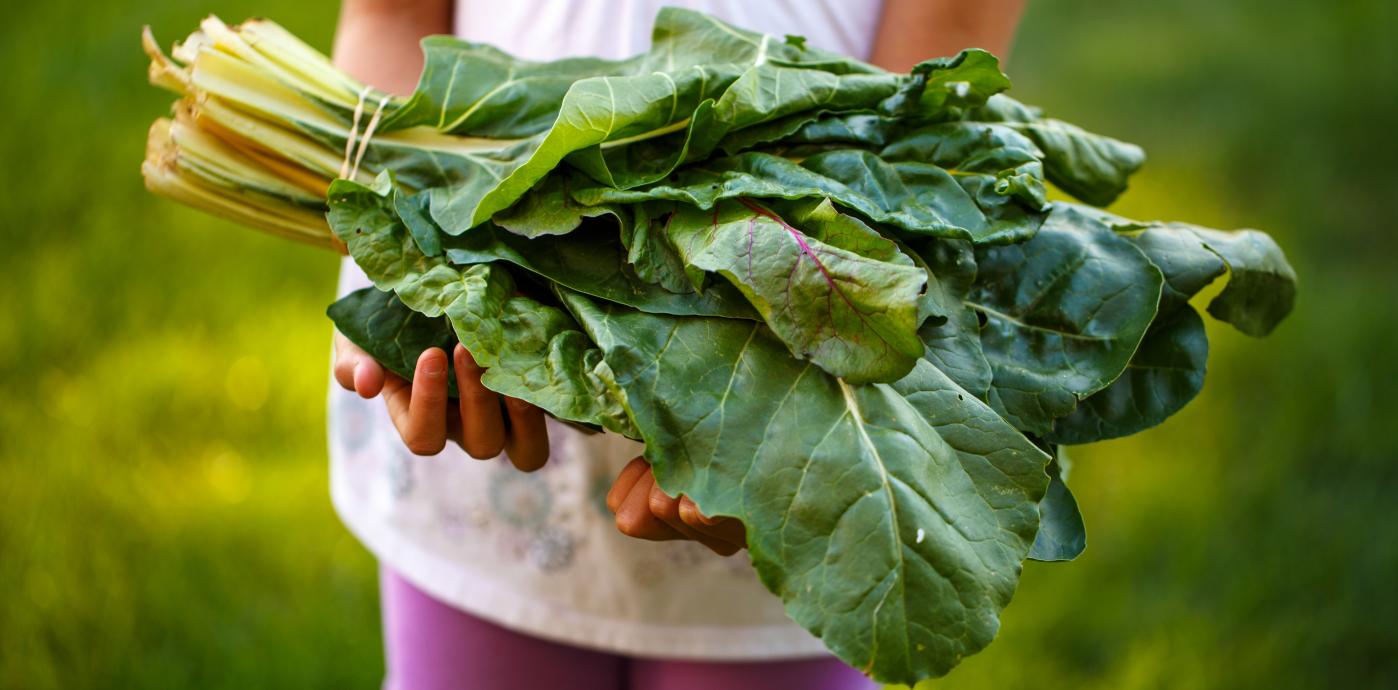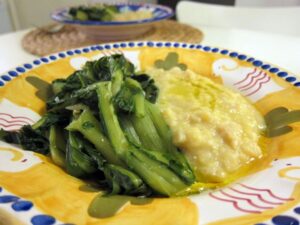Leafy greens are a hallmark of the Mediterranean Diet. In Crete, where Mediterranean Diet studies originated, and all over Greece, it is common to see women, men, and children gathering wild greens on hills and fields.
It is not surprising that the word for vegetarian in Greek is “hortofagos“, which translates to “weed eater.” Thus, we can’t talk about leafy greens without mentioning horta, or Greek boiled greens. While many people equate horta to dandelion greens, there are actually dozens of different types of greens that Greeks use that fall into the horta category. In fact, more than 150 varieties of wild greens grow over the Greek island of Ikaria, designated a “blue zone“, a region of the world where people live longer than average into their 100s.
Any number of wild (foraged), seasonal leafy greens may be classified as horta: dandelion, amaranth, chickory, mustard greens, chard, sorrel, beet, or turnip greens to name a few. Often, they are prepared simply, dropped in salted boiling water until tender and then tossed with a generous drizzle of extra virgin olive oil, squeeze of lemon juice and seasoned with salt and pepper. Horta are also used in savory pies, known as hortopita, as opposed to its more common cousin, spanakopita, which is made with spinach. Similarly, in Turkey, you’ll find greens stuffed into a flaky pastry dough known as börek.
Leafy greens also play a central role in the Italian home. One of the most classic and easy-to-prepare Italian recipes is sautéed greens (such as spinach, mustard greens, kale, broccoli rabe, escarole) with white cannellini beans and garlic. Tuscan kale, also known as cavolo nero, lacinato, dinosaur, or black leaf kale, is also an Italian staple. Tuscan kale is a traditional addition to minestrone soup or ribollita, the latter a hearty and healthy Tuscan soup. The word ribollita translates into ‘reboiled’, indicating that the leftover soup has been thickened with day-old bread (a hallmark of cucina povera, a frugal yet ingenious way to stretch a meal over several days).
Turnip greens (grelos in Gallego) are a favorite vegetable of Galicia in northwest Spain. Lacón con grelos is a classic Galician specialty combining cured pork shoulder, turnip greens, potatoes, and chorizo, all boiled for several hours. Similarly, caldo gallego is a Galician stew of grelos stalks and greens, white beans, potatoes, and pork. In the Catalan region of Spain, greens sautéed with garlic, sultanas or raisins, and pine nuts is a classic preparation, along with spinach and chickpea stew (espinacas con garbanzos) seasoned with Spanish smoked paprika (also known as pimentón).
Beyond the more traditional preparations, dark, leafy greens can be incorporated into just about any meal at any time of day. For instance, fold some leafy greens into your morning omelet, frittata, or breakfast smoothie. Top a pizza with some fresh arugula once it comes out of the oven. Add an assortment of leafy greens, such as mache, frisee, lemony sorrel, watercress, or purslane to your next garden salad. Kale chips make for a healthy and tasty snack when baked in the oven until crispy. Swap out traditional basil for kale, arugula or mustard greenswhen preparing pesto. Or simply sauté your favorite leafy greens in olive oil with lots of garlic, a pinch of chile flakes, and sea salt. And don’t toss the leafy tops of beet greens, turnip greens or kohlrabi; they’re delicious sautéed with garlic and olive oil as well.
Why are greens such a hallmark of the Mediterranean Diet? Dark, leafy greens are nutritional powerhouses, supplying vitamins A, C, E, and K. These vegetables also contain an abundance of antioxidants that protect cells and contain fiber, iron, magnesium, potassium, and calcium. Green, leafy vegetables may help slow cognitive decline associated with aging, improve heart health, regulate insulin, and manage weight. Beyond their obvious health benefts, leafy green vegetables are highly versatile.
Partner these health benefits with the great regional dishes of Greece, Italy, Spain, Turkey, and other countries around the Mediterranean Sea, and you have one more reason to adopt this easy, affordable way of eating. For more ways to incorporate greens into your daily meals, check out our NEW 4-Week Mediterranean Diet Menu Book.
READ MORE
Inflammation and the Power of Leafy Greens
Greens-The Greek Way
12 Great Ways to Use Kale
Want biweekly Med Diet information and recipes in your Inbox? Sign up for our Fresh Fridays newsletter by clicking the Subscribe button at the bottom of this page!
Join the Make Every Day Mediterranean Club Facebook group for additional information and support.








